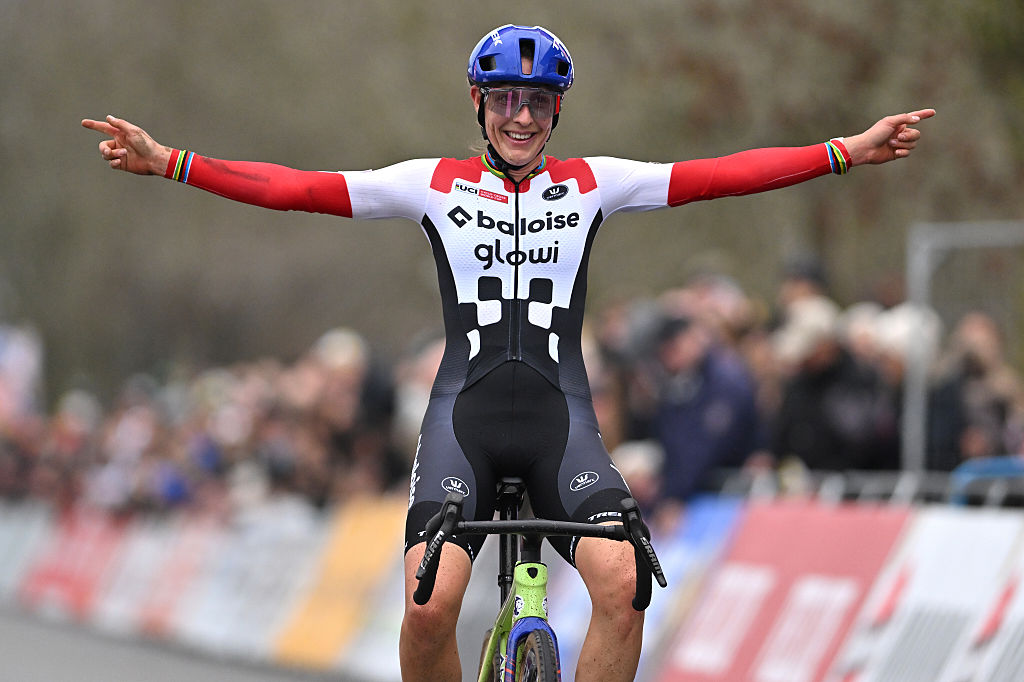'We have to do something about the motorbikes influencing the racing' – An investigation into the dark art of using moto slipstreams in bike races
Is utilising TV motorbike slipstreams just 'part of the game', influencing races unfairly, or downright cheating? What are the ways to stop it? We investigate

"Tadej Pogačar doesn't need help from a TV moto, he's already fast enough and already wins enough…"
Before the start of Il Lombardia, the frustrations of a respected sports director were clear when they spoke to Cyclingnews, and not just because Pogačar had won the Tre Valli Varesine with a downhill attack and a little 'help' from a TV motorbike and because he was about to win a fifth consecutive Lombardia. The 2025 season was coming to an end, but the impact of television and race motorbikes affecting the outcome of major races is still a major problem.
"TV motorbikes have a big impact on race outcomes. We must do something about this, both for fairness and for safety," Adam Hansen, the president of the CPA riders association tells Cyclingnews, when discussing the wider issue.
"It's something we talk about in the peloton all the time," a rider, who preferred not to be named, says.
Pogačar didn't do anything illegal at Tre Valli Varesine; he just attacked off the front when the motorbike was close to him, dived into the slipstream on a fast downhill section and never looked back.
Angry waving from Afonso Eulálio (Bahrain Victorious) and a chase by Quinn Simmons (Lidl-Trek) were too little and too late. Pogačar got a gap, took advantage of a few more moments of motorbike slipstreaming and was never seen again.
It wasn't the first moment of apparent race interference and surely won't be the last.
Simmons missed a chance of a result at Tre Valli Varesine, but another rider suggested he perhaps got a slipstream benefit during his long breakaway at Il Lombardia. On the flip side, the American missed out on success on stage 15 of the Tour de France to Carcassonne after Tim Wellens got the jump on him and other riders in the break.
"It was about the strongest guy and the best moment with the moto," Simmons claimed after that stage in July.
"If you're the lucky one and get away, you get this advantage and there's no chance for the group behind. It's not given for free, you still have to be super strong, but it [the motorbike] is definitely a factor."
"I don’t think the moto played a part in my victory. I hope not," Wellens replied. "But if it were the case, Quinn could also have attacked first and taken the help of the moto…"
A grey area, or even a dark art in racing
Slipstreaming and in-race vehicle help have long been a contentious issue in pro cycling, as long as the sport has existed. Sticky bottles are now frowned upon, but many riders still believe it's fine to sit in team car slipstreams when you're chasing back onto the peloton, especially after a crash or mechanical problem. Using a TV motorbike slipstream is just one of the dark arts of professional cycling and one of the grey areas in the UCI rule book, which leaves room for explanation.
"It's part of the game," one rider tells Cyclingnews.
"It does have a big impact. Aerodynamics is such a huge part of cycling now. If you get the TV moto slipstream when you attack, you can go so much faster. Even just for a few seconds can help you get a decisive gap."
"It's the riders' nature to do everything they can to save energy," Hansen says.
"Energy efficiency wins races and riders will try to find any edge to save energy, be that an aero position, fast wheels, a skinsuit or a motorbike in front of the offering a slipstream. It's not the riders' fault. It's the moto that should not be in front of the riders."
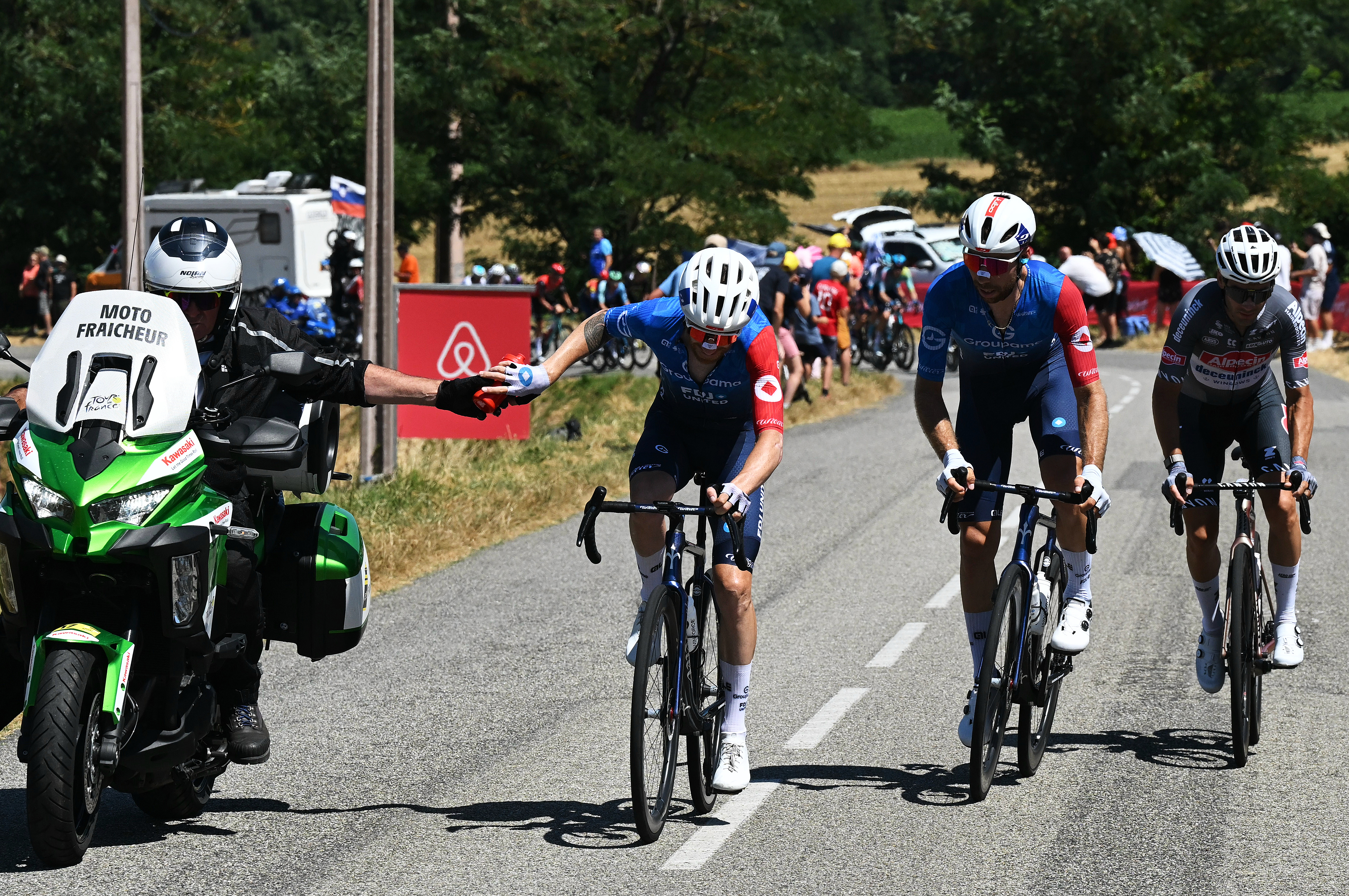
In-race motorbikes are instructed to not position themselves directly in front of the riders
Until the late nineties, on the Poggio in the final kilometres of Milan-San Remo, a pack of television and photographer motorbikes used to sit waiting to capture the moment. Teams and riders knew that the first to attack could get dragged away by the massive motorbike slipstream.
Now, race organisers only allow a so-called 'pool' process, of one television camera and one photographer ahead of the riders during key moments of a race, or sometimes not even that. The television motorbike is no longer allowed to shoot the attacks on the final part of the Poggio, and fixed television cameras and helicopter shots are used on major climbs in other races, even if that reduces the quality of the television footage.
However, the problem of slipstreaming remains an issue in other race situations, especially during long breakaway attacks and peloton chases, especially in stage races. Live television coverage has also been extended for the biggest races, with TV motorbikes capturing the action all day long, from start to finish of races, rather than just the last 90 minutes
"When you're in the middle of the peloton, you can feel when the TV moto is close to the front because the speed goes up like crazy. In the middle of the bunch, you don't get anything like the same draft," a rider tells Cyclingnews.
The same rider recalled how a rival attacked him in a breakaway using a motorbike slipstream out of a corner and stayed away to win the race, while on another occasion, a TV motorbike was so close to a break that it helped them stay away from the chasing peloton.
A source, who preferred not to be identified, claimed that a television motorbike had a huge impact during a stage of the 2016 Vuelta a Espana, slipstreaming a major breakaway that included several GC contenders for several hours. Team Sky tried to lead the chase of the peloton but eventually blew up. Half the peloton finished outside the time limit, with the Sky riders, but the race commissaries extended the time limit to allow them to stay in the race.
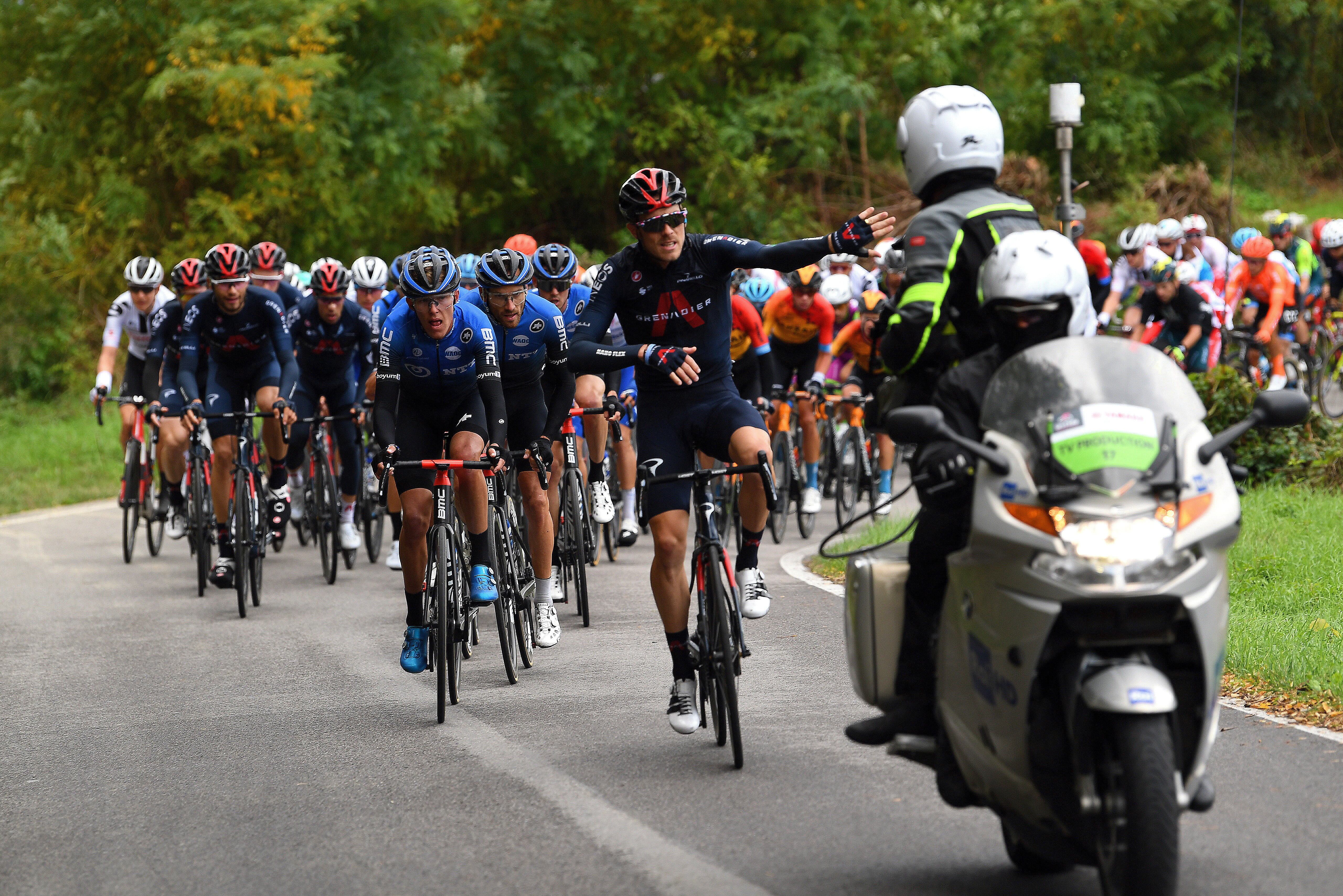
Sometimes you'll see riders remonstrating with motorbikes on the road
Quantifying the slipstream advantage
The advantages of a TV motorbike slipstream have been scientifically quantified.
In 2020, Belgian researcher Bert Blocken and several colleagues at the Eindhoven University analysed and calculated the aerodynamic benefits of drafting behind a bulky TV motorbike equipped with a camera and the data transmission equipment. They carried out simulations in the wind tunnel and made Computational Fluid Dynamics simulations, publishing their results in the Sports Engineering journal.
"For drafting distances of 2.64, 10, 30 and 50m, the drag reductions were 48, 23, 12 and 7%, respectively. The associated time gains were 12.7, 5.4, 2.7 and 1.6 seconds per km," Blocken made clear in his research conclusions.
"Because cycling races are sometimes won by a few seconds or less, these time gains can influence the outcome of the races. Therefore, the common concern in the cycling community that drafting behind motorcycles can influence the outcome of races is correct."
Renaat Schotte is one of the most respected television journalists in professional cycling. He works for Sporza in Belgium and spends hundreds of hours a year commentating on races and reports on the biggest Belgian classics from a Sporza motorbike. He sees the racing in three dimensions from the motorbike; he is inside the race convoy and feels how the wind impacts and changes the racing.
Schotte respects Blocken's research but thinks the real impact on races is exaggerated.
"It's easy to calculate the theoretical advantage of a motorbike slipstream in the wind tunnel, but it's then different out on the open road," Schotte suggests to Cyclingnews.
"A cross or tail wind changes everything in a race, but a lot of people don't see that. Out on the road is not like a wind tunnel; it's real, three-dimensional and is always changing.
"I think the effect of a TV motorbike is more of a placebo effect in the riders' minds. You can see that when you follow a time trial and the sports director shouts at a rider to follow a motorbike. They do it, but often the motorbike is too far ahead to make a difference."
The UCI is aware of the problem of TV motorbikes and slipstreams, but struggles to control and regulate it. The UCI guidelines are not very detailed.
"A TV motorcycle at the front of the peloton moves in front of the riders while respecting a safety buffer and filming from ¾ [at an angle, not head on] in front of riders," the guidelines say.
"They must never interfere with the progress of the race nor allow riders to benefit from their slipstream, especially when the riders’ speed is high."
Cyclingnews reached out to the governing body for comment on the issue of motorbike slipstreaming, but we're yet to get a response.
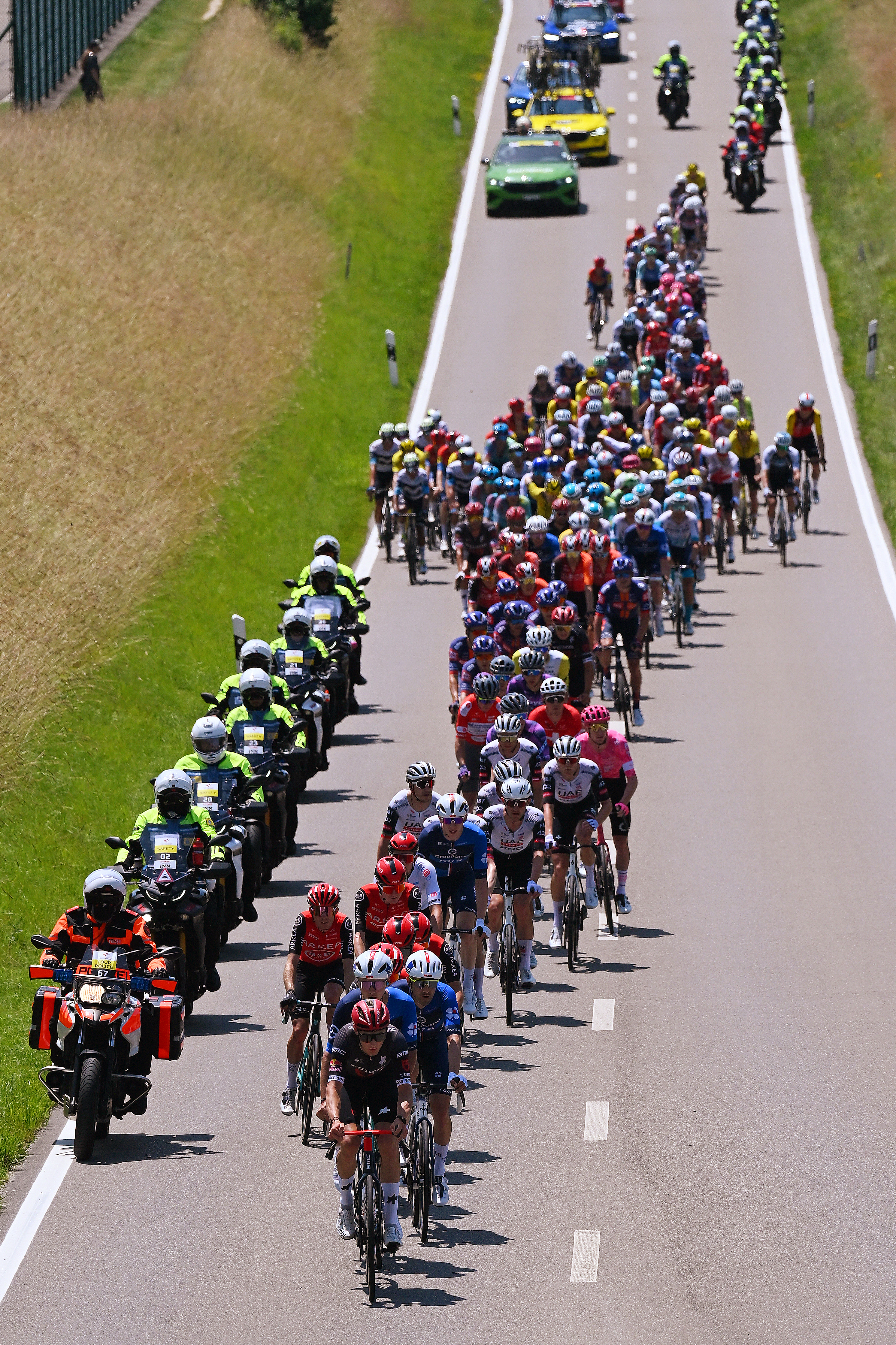
Vast numbers of motorbikes are often part of the race convoy, doing many different jobs
The UCI and SafeR, the dedicated structure created by cycling's stakeholders to study and improve safety in races, implemented a yellow card system in 2025 to dissuade behaviour in the race convoy that could impact safety. A total of 270 yellow cards were issued this year. Many were for riders deviating from their line in sprints, but 39 yellow cards were issued to photo and TV motorbikes. Some were for slipstreaming, even if the exact information is scarce.
Riders and teams believe that the TV motorbikes in some races and some countries behave worse than others, offering more slipstreaming opportunities. There are even suspicions that a few may act maliciously.
"Sometimes it does seem very blatant and so people get suspicious that there's some kind of plot to get a certain winner or result," a rider tells Cyclingnews.
Another source reveals that riders have allegedly given gifts to motorbike pilots in the hope of getting some slipstream help when they attack.
Is there a solution?
Blocken calculated that TV motorbikes generally maintain a gap ahead of the riders of between 10 and 30 metres when they are shooting a breakaway or the peloton. When the gap is consistently less, the aerodynamic benefits for the riders become far greater. He suggests a minimum of 25 metres to greatly reduce the aerodynamic benefit.
"The current rules and guidelines of the International Cycling Union (UCI) do not prevent situations where drafting can occur. The rules and guidelines need to be adjusted to prevent these undesired aerodynamic benefits," he says in his research conclusions.
Most motorbike pilots and the camera crews are experts and highly experienced at what they do. They also have UCI licences to operate in the race convoy and have completed UCI safety courses.
Of course, the TV motorbikes are expected to get the best shot possible, especially in key moments of a race, when the big-name riders are attacking. Everyone watching on television loves to see close-up race action, to see riders' faces as they suffer or distance a rival. The host broadcast director talks to the camera crews via radio, no doubt demanding the best close-up shots. It is a high-pressure situation, which can naturally lead to TV motorbikes going close to the riders to get the shot everyone wants to see.
Schotte explains the need for race motorbikes.
"I know that the whole debate about motorbikes in races can be controversial, but people in their armchairs watching on television don't often understand the importance of race motorbikes and especially TV motorbikes," he tells Cyclingnews.
"I have to defend the TV moto pilots, especially the Belgians, they're really good at what they do. That's not always the case in every country and even amongst the photographers motorbike pilots, but all the motorbike pilots are all human. Riders make mistakes and cause crashes, and moto pilots make mistakes too.
"Deliberately interfering is different and shouldn't happen and punishment has to follow, but there has to be trust between everyone in the race convey, we're all there for a reason."
The cases Cyclingnews has highlighted and the comments from riders, teams and Adam Hansen of the CPA confirm that there is a problem with TV motorbike slipstreaming. It is impacting races – in the eyes of everyone involved. Professional cycling has many other complex problems, but slipstreaming seems avoidable and should surely be resolved.
A solution could be to introduce and then enforce a minimum distance between the riders and the TV motorbikes and any other motorbikes that can provide a slipstream effect. It may impact the quality of the television coverage, but the racing would be fairer. Such a rule has already been introduced in time trials, where team cars have to stay a set distance behind the rider to reduce aerodynamic benefits.
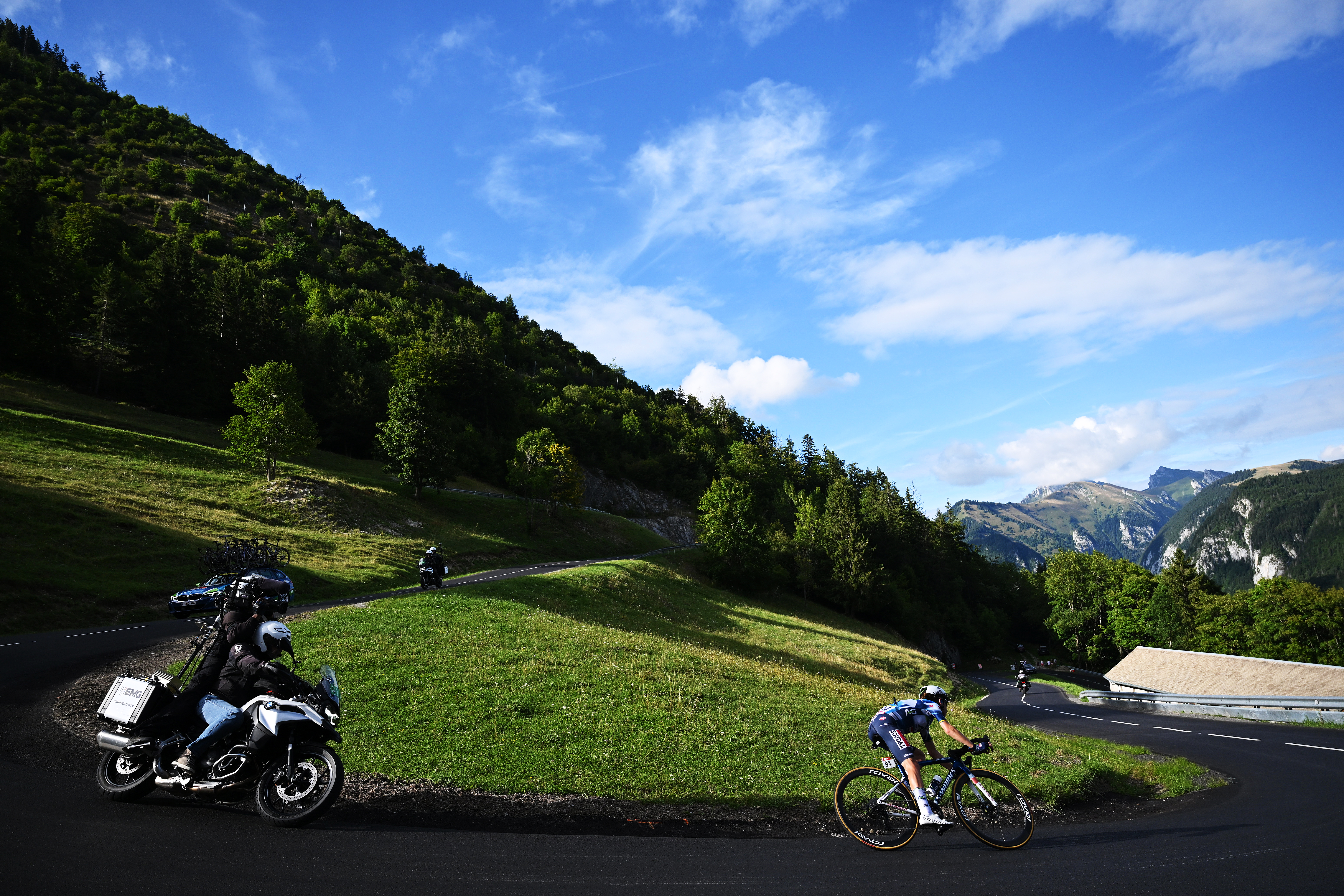
More could be done to ensure motorbikes stay a suitable distance away from riders
One sports director suggested using the same experienced TV motorbike for all of the races and the best possible high-definition lenses with built-in image stabilisation technology. The VAR (video assistant referee) system could also be used more often to spot and punish TV motorbikes or anyone who gets too close to the riders, especially in parts of the race designated as strategic. Drones may one day replace the need for TV motorbikes, but this technology still needs more development and may create other safety issues.
A rider tells Cyclingnews of how endurance triathlon events, where drafting is illegal, use a sensor system to calculate drafting distances and then highlight them with a series of coloured lights on the device.
The Race Ranger pods are similar in size to the data devices used to transmit live rider data and use WiFi, Bluetooth, GPS and UltraWideBand signals to calculate the drafting distance. They could be fitted to the TV motorbikes and other race convoy motorbikes. The measurements could be used to audibly warn the TV motorbikes if they get too close to riders, informing a race commissaire via the VAR system. The lights would indicate to riders if a TV motorbike is at a correct, non-slipstreaming distance.
A sports director suggests that the riders also have to play their part.
"My riders often lament about the TV motorbikes to me via our team radio and I often go to the race commissaire to complain about it," he tells Cyclingnews.
"I tell them to go to the front and wave away the TV motorbikes, but they don't like to be seen doing that. But they have to act and stand up for themselves because they are the ones who lose out if the racing isn't fair."
Adam Hansen believes a solution to the problem of TV motorbikes is needed as part of a wider strategy to improve race safety, even if it impacts the quality of the television footage.
"At SafeR the major discussion is about how to slow down the peloton because the speeds are getting faster and faster, but the TV motorbikes are one of the main factors for increased race speeds," Hansen argues.
"One of the SafeR deliverables for 2026 suggested by the CPA is ensuring the TV moto is further from the riders to make racing fairer. If the UCI really wants to lower the average race speed, we have to do something about the motorbikes influencing the racing."

Stephen is one of the most experienced members of the Cyclingnews team, having reported on professional cycling since 1994. Before becoming Editor-at-large, he was Head of News at Cyclingnews. He has previously worked for Shift Active Media, Reuters and Cycling Weekly. He is a member of the Board of the Association Internationale des Journalistes du Cyclisme (AIJC).
You must confirm your public display name before commenting
Please logout and then login again, you will then be prompted to enter your display name.
